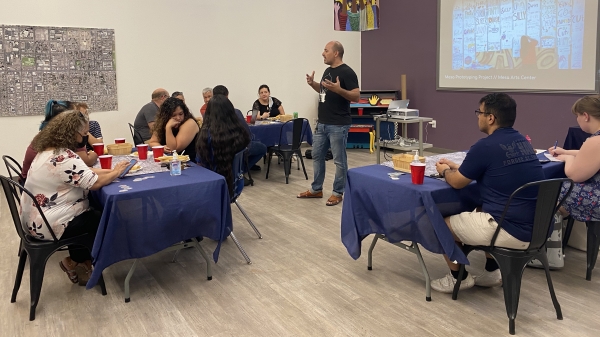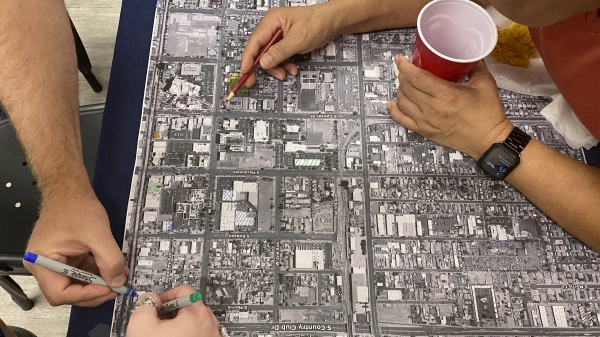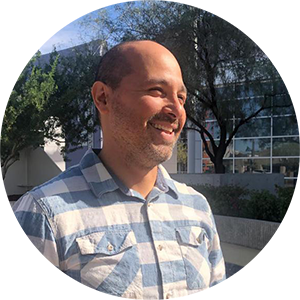
How can we harness the power of community-based solutions to combat displacement?
Augie Gastelum, RAIL CDC
Rafael Martinez Orozco, Southwest Borderlands, ASU College of Integrative Sciences and Arts
Background
With a population of over 80% Black, Indigenous, and people of color (BIPOC), low-income, and Spanish-only-speaking households, Mesa Southside neighborhoods are at high risk for displacement, given that the local government has begun selling land to luxury apartment developers and increasing code enforcement and policing in the area. Displacement could have dire consequences for low-income residents, forcing them into dilapidated mobile home communities on the city’s periphery. Gastelum and Martínez collaborated in pursuit of three goals.
- Understanding how the local community perceives and wants to respond to potential displacement from their neighborhoods
- Establishing effective communication channels between the local community and City of Mesa governance and institutions
- Establishing community leaders to develop solutions to encourage community resilience in the low-income neighborhoods
Research questions
-
How do community members in southwest Mesa perceive gentrification?
-
What actions does the community believe should be taken to address potential displacement?
Methods and findings
The first phase of this project involved community assessments using two innovative community-led models: pláticas and caminatas urbanas. The team hosted pláticas, or culturally relevant ethnographic dialogs, with residents of Southside neighborhoods to perform community assessments and build relationships and trust. These talks were catered by local businesses to inject wealth in the area and raise awareness about its extant economic power. Long-term and more recent community members shared a mix of feelings; some felt gentrification could be positive for development, while others wanted to learn more about its potential impacts.
Gastelum and Martínez worked with RAIL CDC members to conduct caminatas urbanas — walking audits — of the neighborhood with community members. During these audits, residents mapped community resources, the levels of walkability in the area, and places where city policies had been successfully and unsuccessfully enacted. This yielded both a map of the area and field notes about the residents’ perceptions of their neighborhood. To augment this information, the team developed a map using data from Census tracts and City of Mesa datasets.
The project's second phase included a historical survey of the neighborhoods to contextualize findings from the pláticas. Historical and archival analysis suggest a long history of traditional majoritarian narratives that prioritize an Anglo and pioneer settler historiography, while erasing an Indigenous origin and minimizing the contributions and presence of ethnic minorities like those of Mexican, Black, Asian other communities of color who have called Mesa home. Using a community-responsive research approach, the research team talked with local residents and developed two strategies to address colonial narratives about the city and neighborhoods: a public oral history project and an online archive that could be run by residents. Martínez has begun collaborating with ASU’s Chicano/a Research Collection to lead workshops on community-driven archives. The team will also work with local Mesa artist, community organizer and filmmaker Bruce Nelson to create a film documenting some of the residents’ histories of the area.
Partners
Knowledge Exchange for Resilience
-
Lily Villa, PhD candidate and former KER graduate research assistant
-
Fabian Shenk, MAS in Geographic Information Systems & Data Analytics and former KER intern
RAIL CDC
ASU Chicano/a Research Collection
Bruce Nelson, Mesa artist, community organizer and filmmaker
Impact
By engaging with two local businesses from the Southside neighborhoods, RAIL CDC was able to support these businesses' marketing and offered business coaching to the business owners. The hope is that these interactions will help to support place-based wealth creation in the Southside neighborhoods while building community power to counteract potential economic challenges the residents and businesses may face due to potential displacement. Gastelum will continue to use the plática and caminata urbana models tested in this project to implement in other neighborhoods in the city. Currently, his organization is implementing this community assessment model in La Victoria (a historically ChicanX neighborhood straddling Tempe and Mesa).
The public oral history project will serve to expand local narratives about the City of Mesa to include all of its diverse residents. Through narrative shifting, all Mesa residents can potentially raise awareness about the important contributions that BIPOC residents have had on building and sustaining the City of Mesa, and hopefully increase support for residents and reduce the potential for displacement.
Deliverables
Gastelum and Martínez produced a map of Southside Mesa that includes information on demographics, policing, code enforcement, drug use, health information and city policies — a tool that will aid RAIL CDC's ongoing anti-displacement efforts. They also organized an archiving and public history workshop with ASU Library archivists Julie Tanka and Claudia Willett and applied for a grant to further develop the public history project. Explore their visual community archive on Instagram and read Gastelum's account of using pláticas to combat displacement on the Brookings blog:
Augie Gastelum
Project Manager/Lead Consultant
RAIL CDC
Community Fellow, 2021
Augie Gastelum graduated from Scottsdale Community College with an Associates in Buisness. On top of being the founder at Patchwork Community Inclusion, he is the CEO and founder of one of Arizona's largest Cantera stone importers servicing residential and commercial projects. He works closely with builders, developers, architects, designers, landscape architects and pool companies on custom homes. His work includes the Hotel of Scottsdale among other commercial projects.
Rafael Martínez
Assistant Professor of Southwest Borderlands
ASU College of Integrative Sciences and Arts; Southwest Borderlands
Academic Fellow, 2021
Rafael Martínez is an assistant professor of Southwest Borderlands in the College of Interdisciplinary Humanities and Communication. Rafael’s work focuses on immigration, migration, the U.S.-Mexico Borderlands, and the American Southwest. At ASU, he teaches courses on the American Southwest, the U.S.-Mexico Borderlands, and Popular Culture Issues. Rafael is also a Program Faculty for the MA Narrative Studies program in CISA.
As an advocate of community-based-history projects, Rafael is engaged in public projects that seek to connect academic work with community development. As such, he is a current recipient of Knowledge Exchange for Resilience Fellowship where he is co-creating community based research on undocumented populations in the Phoenix Valley. Rafael is part of the inaugural Interdisciplinary Solutions for Social Impact Graduate Faculty program.
Additionally, Rafael is the co-founder of the statewide oral history project, Humans of New Mexico, and also UndocuTalks, a podcast on immigrant rights through an undocumented perspective.




